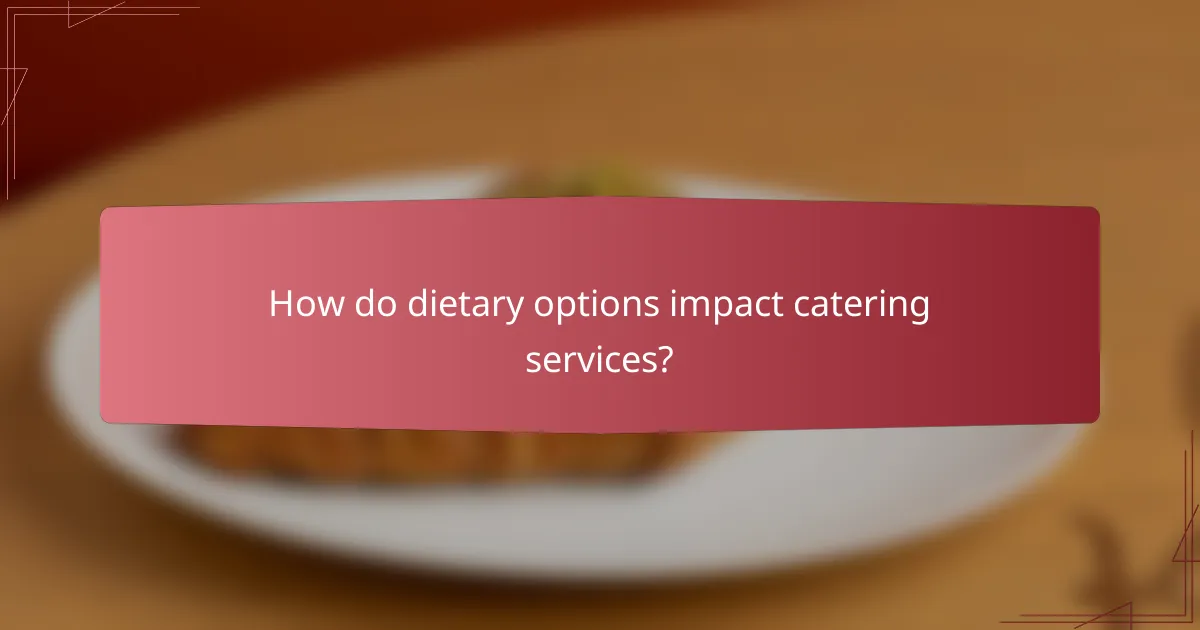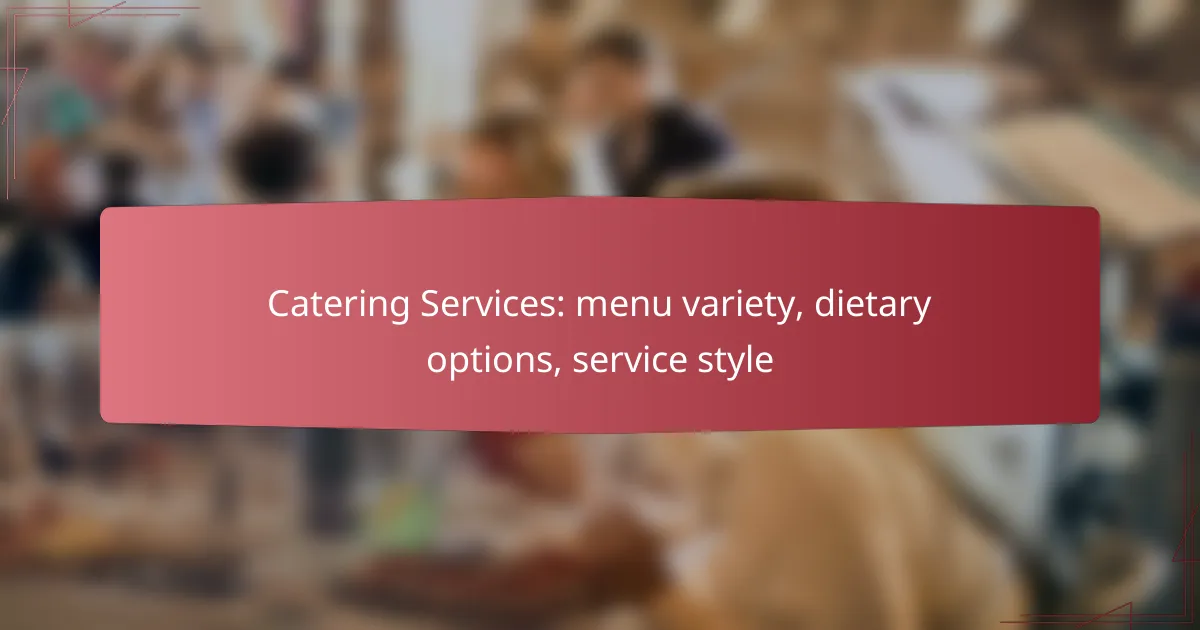In London, catering services offer a wide variety of menu options designed to meet diverse tastes and dietary requirements. Whether you’re hosting a casual gathering or a formal event, these services provide international cuisines and specialized dietary selections to ensure an enjoyable dining experience for all guests.

What catering services are available in London?
London offers a diverse range of catering services to suit various events and dietary needs. From casual gatherings to formal occasions, you can find options that cater to different tastes and preferences.
Buffet catering services
Buffet catering services provide a self-serve dining experience, allowing guests to choose from a variety of dishes. This style is ideal for informal events like parties and corporate gatherings, where mingling is encouraged.
When selecting buffet catering, consider the number of guests and dietary restrictions. It’s common to offer a mix of meat, vegetarian, and gluten-free options to accommodate everyone.
Plated meal catering services
Plated meal catering services serve individual portions to guests at their tables, creating a more formal dining experience. This option is popular for weddings and upscale events where presentation is key.
When planning a plated service, you should finalize the menu in advance, as it typically requires more coordination with the caterer. Offering a choice of entrée can enhance guest satisfaction.
Food truck catering services
Food truck catering services bring a unique and trendy dining option to events, offering a variety of street food-style dishes. This service is particularly popular for outdoor events and festivals in London.
Consider the type of cuisine and the number of guests when choosing a food truck. Many trucks can cater to dietary preferences, making it easy to provide options for everyone.
Drop-off catering services
Drop-off catering services deliver pre-prepared meals to your location, allowing for easy setup without the need for on-site staff. This option is suitable for casual events like office lunches or small gatherings.
When using drop-off catering, ensure you have adequate serving utensils and space for food setup. Check for minimum order requirements, as many caterers have a set number of servings needed.
Full-service catering
Full-service catering encompasses everything from meal preparation to serving and cleanup, making it a comprehensive option for larger events. This service is ideal for weddings, corporate events, and parties where you want a seamless experience.
When hiring full-service catering, discuss your vision and budget with the caterer. They can help you design a menu that fits your theme and manage all logistical aspects, ensuring a stress-free event.

What menu variety do catering services offer?
Catering services provide a diverse range of menu options to accommodate different tastes and dietary needs. From international cuisines to specialized dietary selections, they aim to create an enjoyable dining experience for all guests.
International cuisine options
Catering services often feature a variety of international cuisines, allowing clients to choose dishes from around the globe. Popular options include Italian pasta, Mexican tacos, Asian stir-fries, and Mediterranean mezze, among others. This variety not only satisfies diverse palates but also adds an exciting element to events.
When selecting international cuisine, consider the preferences of your guests and the theme of the event. Offering a mix of familiar and exotic dishes can enhance the overall experience.
Vegetarian and vegan menu choices
Many catering services now provide extensive vegetarian and vegan options to cater to plant-based diets. These menus often include dishes made from fresh vegetables, grains, legumes, and plant-based proteins. Popular choices might include quinoa salads, vegetable curries, and vegan desserts.
When planning a menu, it’s essential to clearly label vegetarian and vegan options to avoid confusion. Additionally, consider offering a variety of flavors and textures to appeal to all guests, regardless of their dietary preferences.
Gluten-free meal selections
Gluten-free meal selections are increasingly common in catering services, ensuring that guests with gluten sensitivities or celiac disease can enjoy the meal. These options may include dishes made with gluten-free grains like rice, quinoa, or corn, and are often prepared in a way that avoids cross-contamination.
When offering gluten-free options, communicate clearly with the catering team about your needs. It’s advisable to have a few gluten-free dishes available to ensure that all guests feel included and satisfied.
Customizable menu packages
Customizable menu packages allow clients to tailor their catering experience to specific preferences and budgets. Many catering services offer flexible options where clients can mix and match dishes from various categories, such as appetizers, main courses, and desserts.
To create an effective customizable package, consider the number of guests, dietary restrictions, and the overall theme of the event. Engaging with the catering team can help refine choices and ensure a cohesive menu that delights everyone.

How do dietary options impact catering services?
Dietary options significantly influence catering services by determining menu variety and accommodating specific health needs. Catering providers must consider allergies, dietary restrictions, and preferences to ensure all guests can enjoy the meal.
Allergy-friendly meal preparations
Allergy-friendly meal preparations are essential for ensuring the safety of guests with food allergies. Caterers should identify common allergens, such as nuts, gluten, dairy, and shellfish, and offer alternatives that are free from these ingredients. Clear labeling and communication about meal contents are crucial to prevent cross-contamination.
For example, a caterer might provide gluten-free pasta or nut-free desserts to accommodate guests with specific allergies. It’s advisable to consult with clients about their guests’ dietary needs well in advance to create a safe and enjoyable menu.
Diet-specific catering for events
Diet-specific catering involves tailoring menus to meet the needs of various dietary lifestyles, such as vegetarian, vegan, keto, or paleo. This approach ensures that all attendees have suitable meal options, enhancing their dining experience. Caterers should be knowledgeable about these diets and able to offer a variety of dishes that align with them.
For instance, a vegan menu might include plant-based proteins, while a keto menu could focus on low-carb vegetables and healthy fats. Discussing dietary preferences with clients before the event helps in crafting a menu that satisfies diverse needs.
Nutrition-focused menu planning
Nutrition-focused menu planning prioritizes the health aspects of the meals served at events. Caterers can create balanced menus that incorporate whole foods, lean proteins, and plenty of fruits and vegetables. This approach not only caters to health-conscious clients but also aligns with growing trends toward healthier eating.
When planning a nutrition-focused menu, consider offering options that are low in added sugars and saturated fats. Providing nutritional information for each dish can also help guests make informed choices. Engaging a nutritionist during the planning phase can enhance the overall quality and appeal of the menu.

What service styles are offered by catering companies?
Catering companies typically offer several service styles to suit different events and preferences. The most common styles include buffet service, family-style dining, and formal plated service, each with its own unique characteristics and considerations.
Buffet service style
Buffet service allows guests to serve themselves from a variety of dishes displayed on a table or serving station. This style is popular for casual events and can accommodate larger groups, as it encourages mingling and socializing.
When planning a buffet, consider offering a diverse selection of dishes, including appetizers, main courses, and desserts. A good rule of thumb is to provide at least three to five options for each course to cater to different tastes and dietary restrictions.
Family-style dining
Family-style dining involves serving large portions of food on platters that guests share at their tables. This approach fosters a communal atmosphere and allows guests to choose their preferred portions.
To implement family-style dining effectively, ensure that the platters are easily accessible and that the dishes cater to various dietary needs. This style works well for medium-sized gatherings and can be more cost-effective than plated service.
Formal plated service
Formal plated service features individual meals served directly to guests at their tables. This style is often used for upscale events, such as weddings or corporate functions, where a polished presentation is essential.
When opting for plated service, consider the menu’s complexity and the number of courses. Typically, a three-course meal (starter, main, dessert) is standard, but you can adjust based on your event’s formality and budget. Ensure to communicate dietary preferences ahead of time to accommodate all guests.



